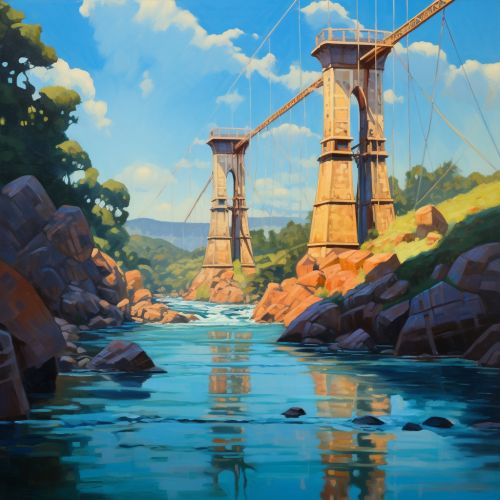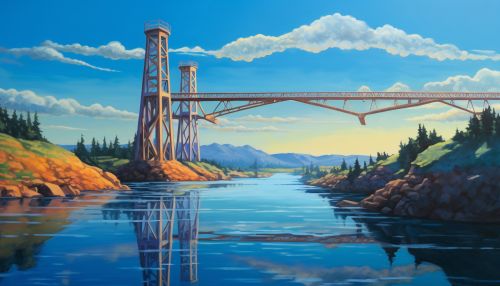Suspension bridge
Overview
A suspension bridge is a type of bridge that has its roadway suspended by cables. The first modern examples of this type of bridge were built in the early 19th century. Simple suspension bridges, which lack vertical suspenders, have a long history in many mountainous parts of the world.
Design
Suspension bridges have the advantage of being well-suited to sites where it would be impractical to use the other principal styles of construction. These include areas with unstable soil, deep waterways or canyons, and where the span (distance between supports) is large. The design of a suspension bridge is simple and straightforward, and takes advantage of several techniques to distribute the weight of the bridge and any loads it carries.
Components
The key components of a suspension bridge are its towers, main cables, anchorages, and the roadway or "deck". The towers are the most visually striking element of a suspension bridge, and they also serve a critical structural role. The main cables run between the towers and are anchored at each end of the bridge; these cables support the majority of the weight. The anchorages are massive structures that resist the tension forces exerted by the main cables. The deck, which can carry pedestrian or vehicular traffic, is suspended from the main cables by smaller vertical cables.
History
The history of suspension bridges spans several centuries, and these structures have been used in many parts of the world. The earliest suspension bridges were made from ropes or vines, and were commonly used in the mountainous regions of South America and Asia. The first wire-cable suspension bridge was the Brooklyn Bridge in New York City, completed in 1883.
Construction
The construction of a suspension bridge involves several steps, starting with the erection of the towers. Once the towers are in place, the main cables are strung between them. The deck is then built, starting from the towers and working towards the center of the bridge. Once the deck is complete, the suspender cables are attached and the bridge is ready for use.
Notable examples
There are many notable examples of suspension bridges around the world. Some of the most famous include the Golden Gate Bridge in San Francisco, the Akashi Kaikyō Bridge in Japan (the longest suspension bridge in the world), and the Tower Bridge in London.
See Also


